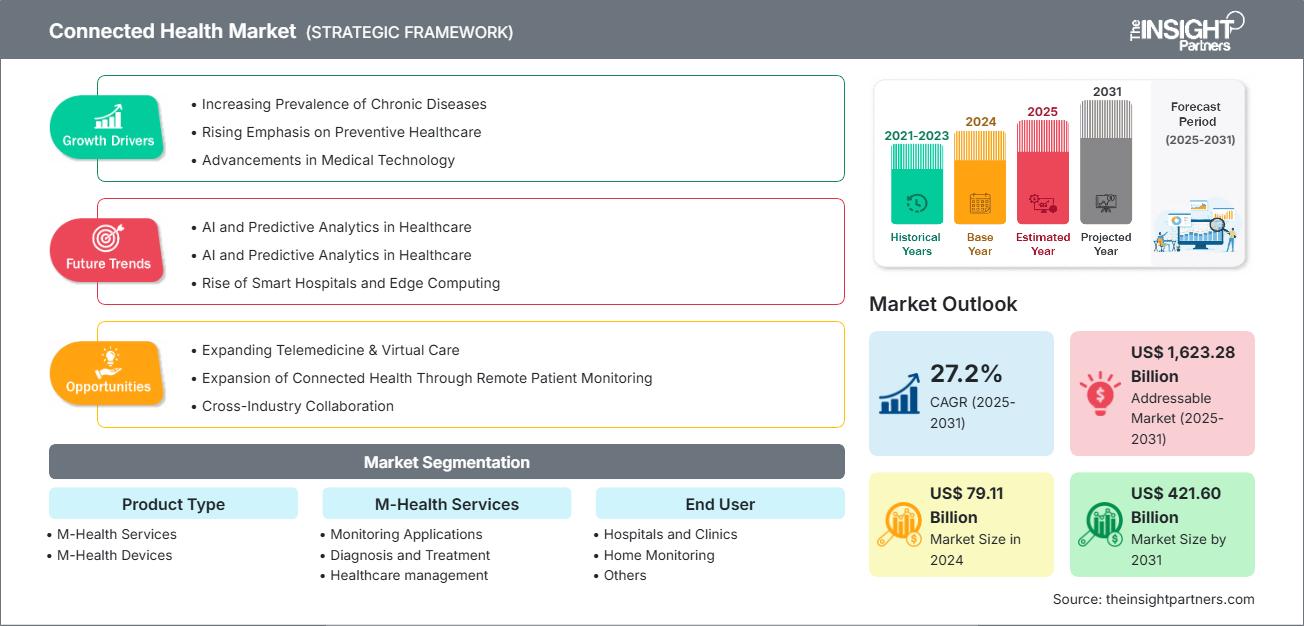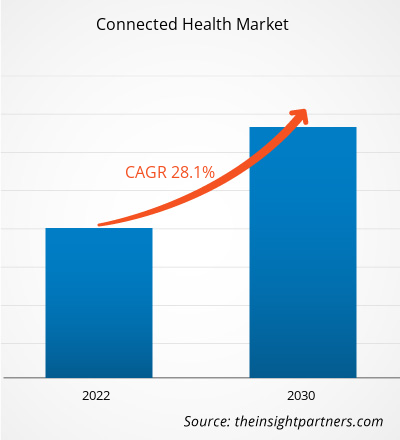[연구 보고서] 커넥티드 헬스 시장 규모는 2022년 626억 1천만 달러로 평가되었으며, 2030년에는 4,535억 6천만 달러에 이를 것으로 예상됩니다. 이 시장은 2022년부터 2030년까지 연평균 28.1% 성장할 것으로 예상됩니다.
시장 분석 및 분석가 의견:
많은 의료 기관들이 가치에 대한 수요와 경쟁 심화로 인해 제공하는 치료의 질을 향상시킬 새롭고 효율적인 방법을 모색하고 있습니다. 환자와 의료 제공자가 "언제 어디서나" 연결될 수 있도록 하는 것은 의료 서비스의 접근성을 높이고 비용을 절감할 수 있는 한 가지 방법입니다. 기술 기반의 통합 의료 서비스 제공 시스템인 커넥티드 헬스(cHealth)를 통해 원격 진단, 치료, 모니터링 및 소통이 모두 가능합니다. 디지털 헬스 도입 증가 및 WHO의 mAgeing 프로그램 등의 요인이 커넥티드 헬스 시장 성장을 촉진하고 있습니다.
시장 성장 요인:
디지털 헬스는 건강 관련 데이터 또는 의료 정보를 수집하고 환자에게 서비스를 제공함으로써 의료 서비스를 더욱 관리하기 쉽고 간편하게 만드는 데 기여합니다. 커넥티드 헬스 기술은 치료, 만성 질환 관리 및 질병 감시를 지원하는 도구입니다. 생활 방식의 변화로 인해 심장병, 당뇨병, 암을 포함한 만성 질환의 발병률이 증가하고 있습니다. 지속적인 모니터링이 필요한 비전염성 질환 환자의 경우, 디지털 헬스는 이러한 요구 사항을 충족하는 데 중요한 역할을 합니다. 많은 경우, 모바일 헬스 기술을 통한 원격 모니터링과 디지털 도구 및 웨어러블 기기를 통한 데이터 평가 덕분에 만성 질환 관리가 변화했습니다. 커넥티드 헬스는 급성 및 사후 대응적 치료에서 사전 예방적 치료로 초점을 전환하는 것 외에도 환자가 의료 서비스 제공자 및 의료 기반 시스템과 소통하는 방식을 변화시켰습니다. 디지털 헬스케어를 저렴하고 편리하게 만드는 기술의 개발 및 구현 증가는 디지털 헬스케어 도입에 기여했습니다. 정보 기술의 발전은 의료 분야의 도입 증가로 이어져 전 세계적으로 커넥티드 헬스(Connected Health)의 급속한 성장을 촉진하고 있습니다. 모바일 헬스(mHealth) 분야에서 휴대폰, 노트북, 태블릿과 같은 기기는 의료 보장 확대에 중요한 역할을 하고 있습니다. 모바일 기술의 발전으로 정부 및 기타 기관들은 생산성 향상과 더불어 현재 건강 데이터를 시의적절하게 활용할 수 있는 역량을 강화하기 위해 모바일 기기 도입에 집중하고 있습니다. 첨단 기술의 급속한 발전은 전자 시스템 간의 데이터 정보 공유를 확대하고, 건강 데이터 보안 강화는 사용자가 정확한 데이터를 확보하고 의사 결정권자가 중요한 의사 결정을 내릴 수 있도록 지원합니다. 따라서 손쉬운 접근성과 다양한 애플리케이션 덕분에 많은 사람들이 디지털 헬스케어를 활용할 수 있게 되었으며, 이는 커넥티드 헬스 시장 성장을 촉진할 것으로 예상됩니다. 의료 사물 인터넷(IoMT) 도입은 향후 몇 년 동안 새로운 커넥티드 헬스 시장 트렌드를 가져올 것으로 예상됩니다.
그러나 많은 의료 기관은 개인 건강 데이터 유출을 초래하는 위험을 안고 있으며, 전자 개인 건강 정보 보호 지침을 제공하지 않습니다. 따라서 이러한 서비스 이용에 대한 위협이 증가함에 따라 건강 데이터 보안도 그에 비례하여 강화되어 커넥티드 헬스 시장의 성장이 제한되고 있습니다.요구 사항에 맞게 이 보고서를 사용자 정의하십시오.
이 보고서의 일부, 국가 수준 분석, Excel 데이터 팩을 포함하여 모든 보고서에 대한 사용자 정의를 무료로 받을 수 있을 뿐만 아니라 스타트업 및 대학을 위한 훌륭한 제안 및 할인을 이용할 수 있습니다
커넥티드 헬스 마켓: 전략적 통찰력

-
이 보고서의 주요 주요 시장 동향을 확인하세요.이 무료 샘플에는 시장 동향부터 추정 및 예측에 이르기까지 데이터 분석이 포함됩니다.
보고서 세분화 및 범위:
“커넥티드 헬스 시장 분석”은 유형, 애플리케이션, 최종 사용자라는 세분 시장을 고려하여 수행되었습니다. 유형별로 시장은 모바일 헬스 서비스와 모바일 헬스 기기로 구분됩니다. 애플리케이션별로 시장은 모니터링 애플리케이션, 진단 및 치료, 의료 관리, 웰빙 및 예방 등으로 구분됩니다. 최종 사용자별로 시장은 병원 및 진료소, 홈 모니터링 등으로 분류됩니다.
세분 시장 분석:
커넥티드 헬스 시장은 유형별로 모바일 헬스 서비스와 모바일 헬스 기기로 구분됩니다. 모바일 헬스 서비스 부문은 2022년에 시장 점유율이 더 높았지만, 모바일 헬스 기기 부문은 2022년부터 2030년까지 커넥티드 헬스 시장에서 더 높은 연평균 성장률(CAGR)을 기록할 것으로 예상됩니다. 커넥티드 헬스는 환자를 의료 시설에서 직접 모니터링하는 대신, 원격 데이터 전송과 가정에서 적절한 의료 서비스 제공에 더 중점을 둡니다. 원격 의료 서비스 제공 외에도, 커넥티드 헬스의 가장 큰 혁신은 방대한 양의 데이터가 제공된다는 것입니다. 커넥티드 헬스 서비스를 통해 의사는 더욱 정보에 기반한 결정을 내리고 환자의 요구를 우선시하는 선제적 치료를 제공할 수 있습니다.
애플리케이션별로 커넥티드 헬스 시장은 모니터링 애플리케이션, 진단 및 치료, 의료 관리, 웰빙 및 예방 등으로 세분화됩니다. 모니터링 애플리케이션 부문은 2022년 시장 점유율 1위를 차지했지만, 진단 및 치료 부문은 2022년부터 2030년까지 커넥티드 헬스 시장에서 가장 높은 연평균 성장률(CAGR)을 기록할 것으로 예상됩니다. 사물 인터넷(IoT), 디지털 센서, 빅데이터 도구와 통합된 원격 모니터링 시스템은 환자 접근성을 향상시켜 의료 서비스 제공 개선에 중점을 둔 새로운 기회를 창출했습니다. COVID-19 위기 동안 이러한 시스템의 도입이 크게 증가했습니다. 원격 건강 모니터링 시스템(HRMS)은 보건소와 병원의 환자 부담 감소 등 다양한 이점을 제공합니다.
최종 사용자별로 커넥티드 헬스 시장은 병원 및 진료소, 홈 모니터링 등으로 세분화됩니다. 2022년에는 병원 및 진료소 부문이 커넥티드 헬스 시장 점유율을 주도했습니다. 그러나 홈 모니터링 부문은 2022년부터 2030년까지 가장 높은 연평균 성장률을 기록할 것으로 예상됩니다. OAE Publishing Inc.에 따르면, 2021년에 모든 미국 병원의 약 절반이 원격 환자 모니터링을 위한 어떤 형태의 연결된 건강을 구현했고, 유럽 국가의 약 80%가 의료 서비스에 원격진료 서비스를 포함시켰습니다.
지역 분석:
연결된 건강 시장 보고서의 범위는 주로 북미(미국, 캐나다, 멕시코), 유럽(스페인, 영국, 독일, 프랑스, 이탈리아, 기타 유럽), 아시아 태평양(한국, 중국, 인도, 일본, 호주, 기타 아시아 태평양), 중동 및 아프리카(남아프리카, 사우디아라비아, UAE, 기타 중동 및 아프리카), 남중미(브라질, 아르헨티나, 기타 남중미)로 나뉩니다.
수익 측면에서 2022년 북미는 연결된 건강 시장 점유율을 지배했습니다. 아시아 태평양 시장은 2022년부터 2030년까지 가장 높은 연평균 성장률(CAGR)을 기록할 것으로 예상됩니다. 아시아 태평양 시장은 인도와 중국 등 글로벌 기업들의 투자 증가, CRO 서비스 기반 확대, 의료 인프라 발전, 그리고 정부 지원 강화에 힘입어 성장하고 있습니다. 또한, Apollo는 2023년 인도에 종합 커넥티드 케어 프로그램(Comprehensive Connected Care Programme)을 도입했습니다. 이 프로그램은 Apollo의 최첨단 커넥티드 케어 기술을 활용합니다. Apollo의 종합 커넥티드 케어 서비스는 전국적으로 시행될 예정이며, 의료진과 간호 인력은 가정 간호, 수술 후 간호, 입원 간호, 응급 및 구급차 서비스를 포함한 환자 관리의 모든 단계에서 최신 환자 정보를 종합적으로 확인할 수 있습니다.
연결된 건강 시장 지역별 통찰력
The Insight Partners의 분석가들은 예측 기간 동안 커넥티드 헬스 시장에 영향을 미치는 지역별 동향과 요인들을 면밀히 분석했습니다. 이 섹션에서는 북미, 유럽, 아시아 태평양, 중동 및 아프리카, 그리고 중남미 지역의 커넥티드 헬스 시장 부문과 지역별 현황도 살펴봅니다.
연결된 건강 시장 보고서 범위
| 보고서 속성 | 세부 |
|---|---|
| 시장 규모 2024 | US$ 79.11 Billion |
| 시장규모별 2031 | US$ 421.60 Billion |
| 글로벌 CAGR (2025 - 2031) | 27.2% |
| 이전 데이터 | 2021-2023 |
| 예측 기간 | 2025-2031 |
| 다루는 세그먼트 |
By 제품 유형
|
| 포함된 지역 및 국가 |
북미
|
| 시장 선도 기업 및 주요 회사 프로필 |
|
연결된 건강 시장 참여자 밀도: 비즈니스 역학에 미치는 영향 이해
커넥티드 헬스 시장은 소비자 선호도 변화, 기술 발전, 그리고 제품 효능에 대한 인식 제고 등의 요인으로 인한 최종 사용자 수요 증가에 힘입어 빠르게 성장하고 있습니다. 수요가 증가함에 따라 기업들은 제품 및 서비스를 확장하고, 소비자 니즈를 충족하기 위한 혁신을 추진하며, 새로운 트렌드를 적극 활용하고 있으며, 이는 시장 성장을 더욱 가속화하고 있습니다.

- 을 얻으세요 커넥티드 헬스 마켓 주요 주요 플레이어 개요
경쟁 환경 및 주요 기업:
커넥티드 헬스 시장 보고서는 Athena Health, AgaMatrix, AirStrip, AliveCor Inc, Allscripts Healthcare LLC, Apple Inc, NXGN Management LLC, Cerner Corporation, Cognizant, Honeywell International Inc.와 같은 주요 기업에 중점을 두고 있습니다. 커넥티드 헬스 시장 전망은 이해관계자들이 성장 전략을 수립하는 데 도움이 될 수 있습니다. 이러한 기업들은 전 세계적으로 증가하는 소비자 수요를 충족하기 위해 신기술, 기존 제품 업그레이드, 그리고 시장 확장에 집중하고 있습니다.
- 2023년 12월, GE HealthCare와 AirStrip은 공동 상용화 계약을 체결했습니다. GE 헬스케어는 미국 내 에어스트립 심장학 및 환자 모니터링 솔루션의 독점 유통업체가 되어 의료 시스템에 데이터 시각화 기술을 제공하고 있습니다.
- 2023년 1월, BioIntelliSense는 care.ai와 파트너십을 맺고 BioIntelliSense의 고주파 생체 신호 추세 데이터와 알고리즘 기반 알림을 care.ai의 주변 모니터링 워크플로에 통합했습니다. 이 파트너십은 이러한 혁신적인 기술의 상호 보완적 기능을 통해 환자 만족도를 높이고, 임상 운영을 최적화하며, 과부하에 시달리는 의료 인력이 직면한 주요 과제를 직접적으로 해결합니다.
- 과거 분석(2년), 기준 연도, CAGR을 포함한 예측(7년)
- PEST 및 SWOT 분석
- 시장 규모 가치/거래량 - 글로벌, 지역, 국가
- 산업 및 경쟁 환경
- Excel 데이터세트
최근 보고서
사용 후기
구매 이유
- 정보에 기반한 의사 결정
- 시장 역학 이해
- 경쟁 분석
- 고객 인사이트
- 시장 예측
- 위험 완화
- 전략 기획
- 투자 타당성 분석
- 신흥 시장 파악
- 마케팅 전략 강화
- 운영 효율성 향상
- 규제 동향에 발맞춰 대응






















 무료 샘플 받기 - 커넥티드 헬스 마켓
무료 샘플 받기 - 커넥티드 헬스 마켓